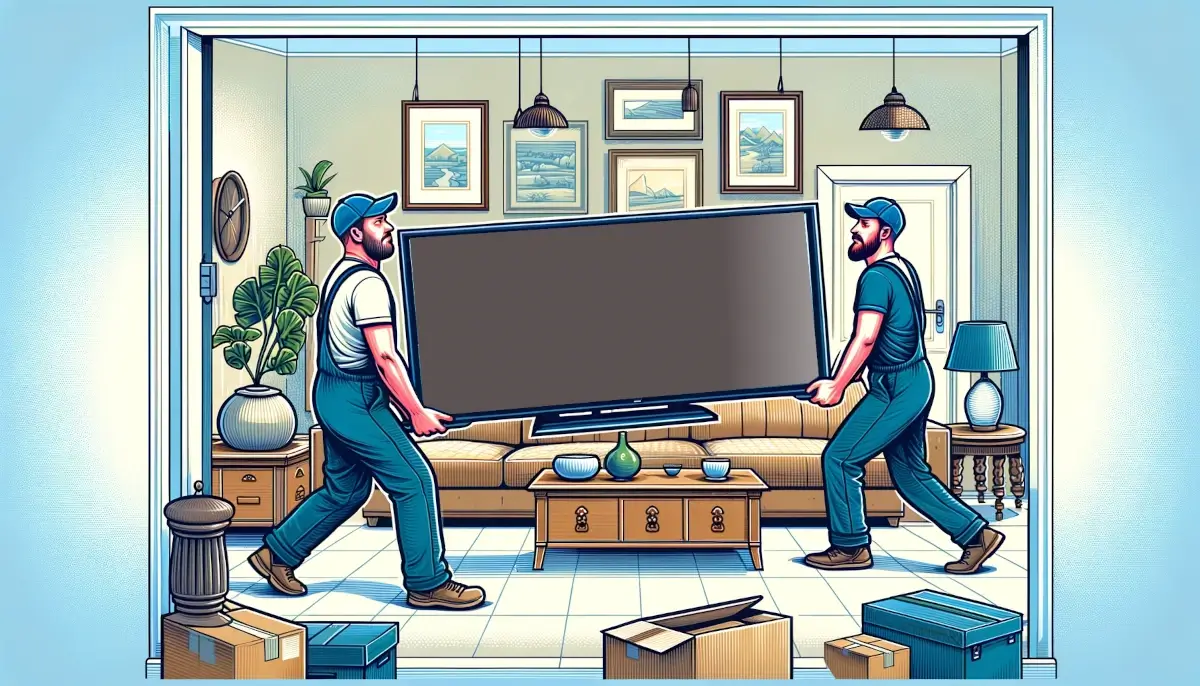How To Pack And Move A TV
Packing and moving a TV can be a daunting task, especially considering that over 50% of all moving-related damage involves electronics, with TVs being one of the most vulnerable items. Improper handling during a move can lead to cracked screens or internal damage, costing hundreds of dollars in repairs or replacements. Ensuring your TV is packed securely and transported safely can save you from these potential headaches and significant expenses.

Table of Contents
Packing and moving TV supplies you will need
When preparing to move a large TV, having all the necessary materials on hand is crucial. Here’s a handy checklist of the items you’ll need:
Original Box or TV Moving Box: Ideally, you should use the original packaging of your TV. If that’s not available, a speciality TV moving box of the right size will do. These are specifically designed to protect televisions during transport.
Bubble Wrap: This provides additional cushioning to protect your TV from impact. It can also prevent scratches on the screen.
Packing Tape: You’ll need this to secure bubble wrap and close the moving box.
Stretch Wrap: This can be used to further secure the bubble wrap and prevent dust from reaching the TV.
Packing Paper: To fill any remaining space in the box and prevent the TV from shifting during transit.
Marker: To label the box, indicating the fragile nature of its contents and the upright position of the box.
If you do not have any of these supplies in hand there are always some alternatives, to protect your TV during the move.
– Soft blankets or towels – Use rope or string to tie the blankets or towels securely around the TV.
– Use the mattress -place the TV against it to use it as a protective barrier inside the van.
– Foam Sheets – If you have foam sheets from other packaging, use them to cover the screen and corners.
– Cardboard Pieces – Use pieces of cardboard to cover the screen and edges of the TV. Secure them with rope or string.
Moving TV preparations
Before you start packing, make sure your TV is ready:
Unplug the TV and all attached cables. It’s a good idea to take a picture of the cable connections before unplugging them, to aid in re-setup at your new place.
Clean your TV gently to remove any dust or dirt. This helps prevent any debris from scratching the screen during the move.
Remove any devices or accessories attached to the TV, such as a streaming device, sound bar, or base stand, and pack these separately.
Looking for moving help that won`t cost a fortune?
Packing the TV process
When packing your large TV for a move, the following detailed steps can help ensure the screen is well protected:
Wrap the Screen: Start by gently wrapping your TV screen with a soft cloth or blanket to protect it from scratches. Once this layer is in place, wrap the entire TV with bubble wrap. Secure the wrap with packing tape, but be careful not to attach the tape directly to the TV as it could damage the surface.
Use Corner Protectors: If available, use foam corner protectors to add extra protection to the corners of the TV, which are particularly vulnerable.
Prepare the Box: If you’re using the TV’s original box, that’s perfect, otherwise, use a special TV moving box that fits your TV size. Make sure the box is clean and dry. Place a layer of packing paper or bubble wrap at the bottom of the box for added cushioning.
Insert the TV: Gently place the wrapped TV into the box. If there’s any space left on the sides or top, fill it with additional packing paper or bubble wrap to prevent movement during transit.
Seal the Box: Once your TV is snugly packed in the box, close the box and seal it securely with packing tape.
Label the Box: Use a marker to label the box as ‘Fragile’ and ‘This Side Up’ to make sure anyone handling the box knows to treat it with care.
Safety Measures:
Avoid rushing the packing process. Taking your time will ensure the TV is properly secured and protected.
Never place the packed TV box flat on its side. Always keep it upright to prevent damage to the screen.
When lifting the TV, always have a partner help. Even if the TV isn’t overly heavy, its size can make it awkward to handle.
Finally, consider covering your TV with moving insurance for added peace of mind, especially if it’s a high-value item. If you’re using professional movers, ask them about their coverage options.
What is the cost of a TV moving box in the UK?
- £25-£27 for up to 40” TV
- £28-£30 up to 59” TV
- £38-£42 up to 75” TV
Moving the TV and loading process
To safely move a large TV, careful handling is essential to avoid damage. Here’s the best way to do it:
Handling and Transporting the TV
– Lifting a large TV should be a two-person job. Both should lift using their legs instead of their backs to prevent injury. Hold the TV securely from both sides for even weight distribution.
– Keep the TV vertical. It’s best to carry TVs, especially flat screens, in an upright position. This reduces screen stress and lowers the chance of damage. You can also place the TV between flat unused boxes to increase safety.
Place Thoughtfully
– Don’t place anything on top of the TV as the extra weight can cause harm.
– Use moving straps to secure the TV and nearby items if there’s a risk of them shifting or falling.
– Aim to maintain a consistent temperature in the vehicle to prevent potential damage from extreme heat or cold.
If you’re unsure about doing it yourself, consider hiring professionals who are equipped and experienced in this task.
Check also: Why Are Moving Companies So Expensive?
Setting up the TV at your new home
Setting up your TV in your new home involves unpacking it carefully and setting it up correctly. Here are the steps:
Unpacking the TV
If you have hired movers to help you move home, ask them to unwrap, plug and turn the TV on to make sure it wasn’t damaged visually and internally during the move. It is much easier to get compensated for damage when you find the issue during the moving process, not after. If possible, always try to test any of your appliances and media during the unloading.
If you are doing the move yourself, place the TV on the floor and carefully remove the protection covers. Do not plug the TV while still wrapped to avoid electrical faults.
Setting Up and Reinstalling the TV
Choose the right spot for your TV, considering glare, viewing angles, and proximity to power outlets. Reattach the base or mount and reconnect cables using a photo reference if needed. Plug in and switch on the TV to ensure it works, then clean the screen with a microfiber cloth.
Remember, take your time during the setup process to ensure everything is done correctly and safely. Enjoy your TV in your new home!
Packing and moving a TV into storage
If you’re moving your TV into storage, it’s important to wrap and pack it properly to ensure it stays protected over time. Use the original box if you still have it and plenty of bubble wrap.
Choose a suitable spot for storage, ensuring it’s dry, cool, and free from dust. Before storing, remove any detachable parts like the base or mount and pack them separately. Wrap the TV securely to protect it from scratches and damage, and position it upright in the storage unit to prevent pressure on the screen.
If possible, always place the TV on the floor. If placed somewhere high, there is always a chance it might fall being pushed when you are trying to get or store more stuff. It is also important to be visible as if you place the TV behind other items, you might forget and damage it by pushing it with some heavy furniture or sharp objects.
Check also: How Much Removals Cost?
Hire professional movers to move the TV
Handling large and fragile items like a TV can be a challenging task, which is why hiring professional movers can often be a wise choice.
Advantages of Hiring Professional Movers
Here are some advantages:
– Professional house moving experts are trained to handle bulky and fragile items, ensuring that your TV and other belongings are moved safely.
– They have the experience and equipment to pack and transport items quickly and efficiently, which can save you significant time and effort.
– Most professional movers offer insurance coverage for your items, providing peace of mind in the event of any accidental damage.
– Hiring professionals can alleviate the stress of moving, allowing you to focus on other aspects of the move.
Finding a Reliable Moving Company
When looking for a moving company, consider the following:
Recommendations and Reviews: Start by asking friends and family for recommendations. Additionally, look for online reviews and ratings to assess the reputation of the company.
License and Insurance: Ensure that the company is licensed and insured. This is vital for your protection and is a good indicator of a legitimate, professional operation.
Services Offered: Verify that the company offers the specific services you need, such as packing and transporting large, fragile items.
Quotes and Estimates: Get quotes from several companies. While price should not be the only determining factor, it can help you understand the market rate and avoid overpaying.
Ask Questions: Don’t hesitate to ask questions about their experience, how they handle fragile items, what their insurance covers, etc. Their willingness to answer can tell you a lot about their customer service.
Hiring professionals can make the moving process smoother and safer, especially when dealing with large, fragile items like a TV. Do your research to ensure you choose the right movers for your needs.
Do movers remove wall-mounted TVs?
Yes, many moving companies offer services to remove wall-mounted TVs. It’s important to confirm this service in advance, as some companies might charge an additional fee. Ensure that the movers have experience with handling and dismounting TVs to prevent any damage.
If you believe this can help someone else, please share it. Thank you.
Compare Services
Why Matching Quotes?
» Find quality and careful movers.
» Get prices for multiple services.
» Local movers only.
» No time wasted searching.
Get Free Estimates
We will share your details only with selected 5 or 6 local moving companies, so they can provide quotes for your moving request.
